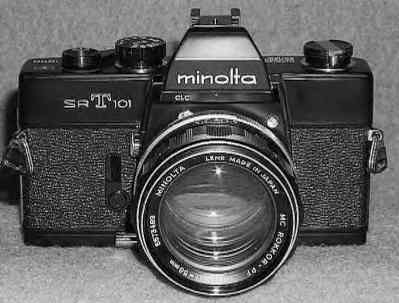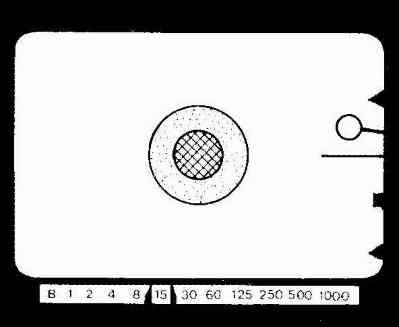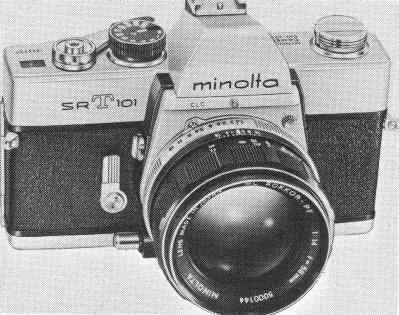

SRT101
(1966) Minolta had finally done it. In 1966, it began production of an SLR with a TTL meter and interchangeable lenses. It took the industry by storm and blew away the competition. Why? Because it operated with a fully-automatic aperture! Sure, there were lots of other German and Japanese 35mm SLR cameras that had auto-diaphragms, interchangeable lenses, and even built-in, TTL meters, but all of them had at least one major drawback. For example, the other camera companies that were offereing TTL metering at that time were using awkward, stop-down metering systems, such as the Asahi Spotmatic of 1964, the Canon FT of 1966 and the Mamiya 1000TL of 1966. So even if their camera sported auto-diaphragm lenses, the photographer still had to stop-down the lens in order to take a meter reading. In this metering approach, you press a switch on the camera body which stops-down the lens and activates the meter. Only at that point can the meter take a reading. Not only is this process awkward, it defeats the whole purpose of having an automatic lens -- to keep the lens open and the viewfinder bright until the instant of the exposure! Other cameras, such as the Nikon Nikkormat of 1965, whcih had full-aperture metering, required the photographer to match up lugs on the camera and the lens -- before attaching the lens -- for accurate metering. What a pain! But Minolta was able to avoid all of these pitfalls.
The biggest technical obstacle to developing a TTL metering system with fully automatic lenses is that the meter in the camera needs to know the f-stop setting on the lens -- because an automatic lens always stays at it maximum aperture. The lens and the camera have to be able to "talk" to each another. For most other camera manufacturers, the f-stop ring had been placed in the middle or at the front of the lens. This made linking the f-stop ring and the camera's TTL metering system a difficult challenge. For most companies, this would mean redesigning their entire line of SLR lenses. Instead, they offered the consumer stop-down metering, and hoped no one would notice.
Minolta was able to avoid the whole problem of "stop-down" metering because they happened to design most of their Auto-Rokkor lenses -- from the very beginning -- with the aperture ring next to the camera body. By placing a small lug on the Auto-Rokkor f-stop ring, and placing a matching spring-loaded pin on the SRT101 camera body, the problem was solved. The lens conveys the selected f-stop to the camera meter as the aperture ring is turned. The pin on the camera conveyed the f-stop adjustment to the built-in, TTL meter. A 4mm change in the f-stop ring on the lens changes the TTL meter reading in the camera by one f-stop. The meter is then able to determine the appropriate shutter speed -- for that scene, shutter speed and film speed -- while the lens diaphragm stays open at its maximum setting. This is just one of the reasons why Minolta was able to keep their lens mount the same over all these years, while nearly every other camera manufacturer has had to make significant changes in their lenses.
With this modification, the MC Rokkor lenses were born and stop-down metering became a thing of the past -- well, if you owned a Minolta SRT101! The "MC" in "MC Rokkor" refers to "meter-coupling" -- not "multi-coating", as some people think. These lenses were double-coated -- the first lenses ever to offer "multi-coating" (more than one layer of coating). At the time, Minolta didn't refer to it as "multi-coating". They called it "Achromatic coating", but "multi-coating" it was! The older Rokkor and Auto-Rokkor lenses will fit on the new SRT camera because the mount is the same, and will operate correctly, but they cannot couple to the TTL metering system of the SRT101. Metering with non-MC lenses is accomplished in the "stop-down" fashion.
One challenge to the new system was that, since the lenses remain at the
maximum aperture regardless of the pre-set f-stop, there is no way for the
photographer to view the actual depth-of-field in the viewfinder -- as you
could do easily with older lenses by just pressing the built-in DOF button
on the lens. While this approach could still be used with lenses sporting
a DOF button, Minolta addressed the issue directly by adding a new DOF
(depth-of-field) button to their new SRT101 camera. This was an easy
item for Minolta to add since it was a feature that they had already tried
out on the Minolta SR777 prototype. In fact, a stop-down
button was required on the SR777 since it was designed
to use stop-down metering. Pressing the stop-down button, stops an
automatic lens down to the pre-set aperture, so that you can view the actual
depth-of-field in the viewfinder. On cameras with stop-down metering, this
button is called the stop-down metering button, but on Minolta cameras, because
it is primarily used to check depth-of-field, it is referred to as the DOF
button.
But the new TTL meter and new meter-coupled lenses were not the end of the
new features of the Minolta SRT101. That would have been enough to
set the industry on fire, but Minolta didn't stop there. Unlike lenses
from other companies, the MC Rokkor lenses were a simple bayonet mount. And
I mean simple. Just push a button to take the lens off and just insert and
twist to put the lens on. With other companies, like Nikon, Canon, etc. the
photographer had to set the f-stop on the lens before attaching it (no kidding)
or set the shutter speed before attaching the lens (no kidding) or adjust
the ASA film speed setting before attaching the lens (no kidding) or cock
the shutter before attaching the lens (no kidding) or release the shutter
before attaching the lens (no kidding). It's hard to believe the torment
that non-Minolta users went through!
In addition, the new Minolta TTL meter readout was moved from the top of the camera, as in the SR-7, and was placed inside the viewfinder -- an incredible innovation in miniaturization and convenience. Up until now, photographers would compose the scene in the viewfinder and then have to drop the camera to make exposure adjustments -- and then raise the camera again and re-compose. One word -- S-L-O-W!

In the SRT101, two "needles" were placed on the right-hand side of the viewfinder and connected to the aperture, shutter speed and film speed settings. By changing any of these factors, the needles would match up when the exposure was correct. Just get the needle inside the circle and your exposure will be fine. And to top it off, Minolta added a battery-check tab in the viewfinder, as well as over- and under-metering-range triangles for very bright and very dark situations. Yet another new feature of the SRT101 is that the complete range of shutter speeds (1 second to 1/1,000, plus B) is visible in the viewfinder, so you no longer needed to remove your eye from the viewfinder to adjust the shutter speed -- and take a picture. Other new features included a built-in flash shoe and a switch to turn off the meter -- the latter being a lesson Minolta learned from the SR-7. The other important advances of the SR-7 were retained, such as the mirror lockup for the super-wide 21mm lens, and a self-timer.
Minolta studied thousands of photographs in order to determine the best way to accomplish accurate TTL metering. Different companies had different designs, but Minolta noticed that a large proportion of photographs were really two scenes in one: an upper-half which was often a bright sky, and the lower-half which was typically a darker foreground. Many pictures were incorrectly exposed due to the inclusion of the bright sky which "over-powered" the foreground and caused the meter to underexpose the main subject -- which is usually in the foreground. Minolta devised an innovative solution, with a simple modification to the typical TTL metering system. While most TTL manufacturers used one CDS cell affixed inside the pentaprism, Minolta employed two cells pointed in two directions. This allowed the camera's meter to view, and compare two different areas of the picture. The Minolta engineers determined that the typical exposure could be dramatically improved if the sky-portion of the scene had less effect on the exposure. They were able to accomplish this by having one CDS cell reading the sky (or upper portion of the scene), and a second CDS cell reading the lower-portion of the scene. The brightness of the sky was then easy to control, and no longer overwhelmed the foreground reading. Minolta dubbed the new system "CLC" which stands for "Contrast Light Compensation". On SRT series cameras, if the CLC system is used, it is imprinted on the front plate of the camera, just below the "M" in "Minolta".
There were actually three versions of the SRT101, with slight variations
over time, however, these model numbers are not inscribed on the cameras.



The SRT101 would have sold much better had there been better marketing by Minolta. With all of the other camera companies touting their "automatic lenses", "built-in meters", "TTL metering", "professional features", ad nauseum, it was difficult for the average consumer to separte the wheat from the chaff. Full-aperture metering was a new concept and the typical new camera buyer had no idea how important it was. And Minolta's marketing never told them. Likewise, the other companies never mentioned in their ads that there were serious limitations to their "advanced metering features", like the need to stop-down the lens. The benefits of full-aperture metering were incomprehensible to someone who had never owned an SLR camera before. In fact, Nikon, Canon, Pentax, and Olympus were unable to produce any TTL, full-aperture SLR cameras until 1972 -- six years after the SRT101 made its debut! Still, despite the lackluster marketing, the SRT101 sold well and was manufactured from 1966 until 1975 -- a run of nine years -- when it was replaced by the more fully-featured SRT201. The SRT101 was one of the most innovative cameras in photographic history. In fact, it is held in such high regard that an SRT101, in like-new condition, will sell for more today that it cost in 1966!
For a comparative look at the major features of the SRT101 models, check out MINMAN's SLR table -- the world's most complete!
| Camera | SRT-101 | SRT-101 | SRT-101 |
| Model | a | b | c |
| Years made | 1966-1969 | 1969-1971 | 1971-1975 |
| Type | Mechanical 35mm SLR | Mechanical 35mm SLR | Mechanical 35mm SLR |
| Shutter | Fully mechanical, horizontal, cloth focal plane shutter | Fully mechanical, horizontal, cloth focal plane shutter | Fully mechanical, horizontal, cloth focal plane shutter |
| Metering | Built-in TTL CDS meter coupled to shutter speed, aperture, and film
speed Contrast Light Compensation (CLC) metering method using dual CDS cells in pentaprism |
Built-in TTL CDS meter coupled to shutter speed, aperture, and film
speed Contrast Light Compensation (CLC) metering method using dual CDS cells in pentaprism |
Built-in TTL CDS meter coupled to shutter speed, aperture, and film
speed Contrast Light Compensation (CLC) metering method using dual CDS cells in pentaprism |
| Meter sensitivity | EV 3 to 17 | EV 3 to 17 | EV 3 to 17 |
| Exposure modes | Unmetered manual Metered manual using matched needle method |
Unmetered manual Metered manual using matched needle method |
Unmetered manual Metered manual using matched needle method |
| Automatic exposure adjustment |
-- | -- | -- |
| Viewfinder | Fixed eye-level pentaprism with complete range of manually selected shutter speeds, over- and under-exposure marks, battery check mark, and two manual exposure match needles | Fixed eye-level pentaprism with complete range of manually selected shutter speeds, over- and under-exposure marks, battery check mark, and two manual exposure match needles | Fixed eye-level pentaprism with complete range of manually selected shutter speeds, over- and under-exposure marks, battery check mark, and two manual exposure match needles |
| Focusing screen | Fresnel-field screen with a micro-prism center | Fresnel-field screen with a micro-prism center | Fresnel-field screen with a micro-prism center |
| Lens mount | Minolta SLR bayonet | Minolta SLR bayonet | Minolta SLR bayonet |
| Lenses | Optimum: MC
Rokkor Usable: Auto Rokkor, Rokkor, MC Rokkor-X, MC Celtic, MD Rokkor, MD Celtic, MD Minolta |
Optimum: MC
Rokkor Usable: Auto Rokkor, Rokkor, MC Rokkor-X, MC Celtic, MD Rokkor, MD Celtic, MD Minolta |
Optimum: MC
Rokkor Usable: Auto Rokkor, Rokkor, MC Rokkor-X, MC Celtic, MD Rokkor, MD Celtic, MD Minolta |
| Mirror | Instant return, oversized mirror with lock-up | Instant return, oversized mirror with lock-up | Instant return, oversized mirror |
| Film speeds | ISO 6 - 6400 | ISO 6 - 6400 | ISO 6 - 6400 |
| Shutter speeds | Mechanical: 1 - 1,000; B Manual: 1 - 1,000; B |
Mechanical: 1 - 1,000; B Manual: 1 - 1,000; B |
Mechanical: 1 - 1,000; B Manual: 1 - 1,000; B |
| Flash synch | X: B; 1 - 1/60 FP: B; 1 - 1/1,000 M: B; 1 - 1/15 MF: B; 1 - 1/30 |
X: B; 1 - 1/60 FP: B; 1 - 1/1,000 M: B; 1 - 1/15 MF: B; 1 - 1/30 |
X: B; 1 - 1/60 FP: B; 1 - 1/1,000 M: B; 1 - 1/15 MF: B; 1 - 1/30 |
| Flash connection | Built-in, cold shoe X and FP PC contacts |
Built-in, cold shoe X and FP PC contacts |
Built-in, cold shoe X and FP PC contacts |
| Film counter | Automatically resetting type counting upward | Automatically resetting type counting upward | Automatically resetting type counting upward |
| Battery | one 625 mercury battery | one 625 mercury battery | one 625 mercury battery |
| DOF/Stop-down button | Yes, locking type | Yes, locking type | Yes, locking type |
| Film Back | Non-interchangeable | Non-interchangeable | Non-interchangeable |
| Multiple exposures | No | No | No |
| Film advance | Lever type | Lever type | Lever type |
| Self-timer | Mechanical, overrideable, non-cancellable, adjustable from 4 to 10 seconds | Mechanical, overrideable, non-cancellable, adjustable from 4 to 10 seconds | Mechanical, overrideable, non-cancellable, adjustable from 4 to 10 seconds |
| Film reminder | ASA speed selector Rotating ASA/DIN converter |
ASA speed selector Rotating ASA/DIN converter |
ASA speed selector |
| Other | Cable release connection, tripod socket | Cable release connection, tripod socket | Cable release connection, tripod socket |
| Body size | 1 7/8 x 3 3/4 x 5 3/4 inches | 1 7/8 x 3 3/4 x 5 3/4 inches | 1 7/8 x 3 3/4 x 5 3/4 inches |
| Body weight | One pound nine ounces | One pound nine ounces | One pound nine ounces |
RETURN TO THE MANUAL MINOLTA HOME PAGE
We didin't want to do this, but since other websites have been stealing our
stuff, we have no alternative but to state:
COPYRIGHT@1995-2023 by
Joe McGloin.
All Rights Reserved. The material on this website is protected by US Federal
copyright laws. It cannot be copied or used in any manner without specific
approval from the owner.
The material on this website is protected by US Federal copyright laws. It cannot be copied or used in any manner without specific approval from the owner.